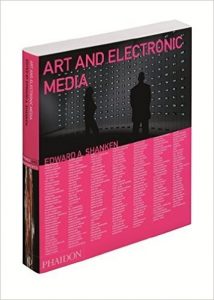Created by renowned Cybernetic artist Les Levine in 1969, Contact: A Cybernetic Sculpture is a wall of 18 CRT television screens arranged as a pair of three by three grids which show video of the viewer through close-up shots, wide-angle imagery, and a simple medium range portrait. Using an array of eight cameras contained in a stainless steel console and four additional cameras on each side of the grid of televisions all 18 screens showed live footage that was overlayed with images of Gulf & Western employees at work. Every few seconds the images on the screen would switch places with another image on another screen; limiting the amount of time that the viewer spent looking at just one angle. A different shade of colored acrylic gel was placed over each of the nine screens in the first block and the pattern was repeated in the second block forcing the viewer to look at themselves in a distorted version of the thrid person perspective.
Comissioned by a company named Gulf & Western Industries, Contact went on a short tour before it was installed in the lobby of a then-new Gulf & Western building in New York City. Since that time Gulf & Western has merged with Viacom and the company's headquarters were sold off and rebuilt as the Trump International Hotel and Tower. Contact is not presently on display.

According to Levine himself, “Contact is a system that synthesizes man with his technology. In this system, the people are the software. It relies totally on the image and sensibility of the viewer for its life. It is a responsive mechanism and its personality reflects the attitudes of its viewers. If they are angry, the piece looks angry. Contact is made not only between you and your image, but how you feel about your image, and how you feel about that image in relationship to the things around you. The circuit is open.”
Contact is a work of art that is based around the viewer's perception of themselves. Although the installation modulates the viewer's input to create its output the impact of the piece relies upon the emotions of the viewer. A feedback loop is cerated where Contact's reflection of the viewer's current mood elecits a change in the mood of the viewer. This is why Contact is a cybernetic sculpture; its a machine that uses viewer to make an impact on the viewer and melds man and machine in the process.
It’s interesting to compare early cybernetics work like Contact to more modern surveillance pieces like Sanctum which also displays images of the viewer. Although the aim of these two pieces is very different, they use the same techniques to force the viewer to enter a period of self-reflection and introspection about their external appearance and the underlying feelings that are manifest through their appearance. Admittedly isn’t necessarily the primary goal of Sanctum and you are likely to be distracted by a discussion of the modern surveillance state after considering your own vanity, but it’s a key area where its effect on the viewer aligns with that of Contact.
[1] Edward A. Shaken, 2002, Cybernetic and Art: Cultural Convergence in the 1960s, Pg. 7
